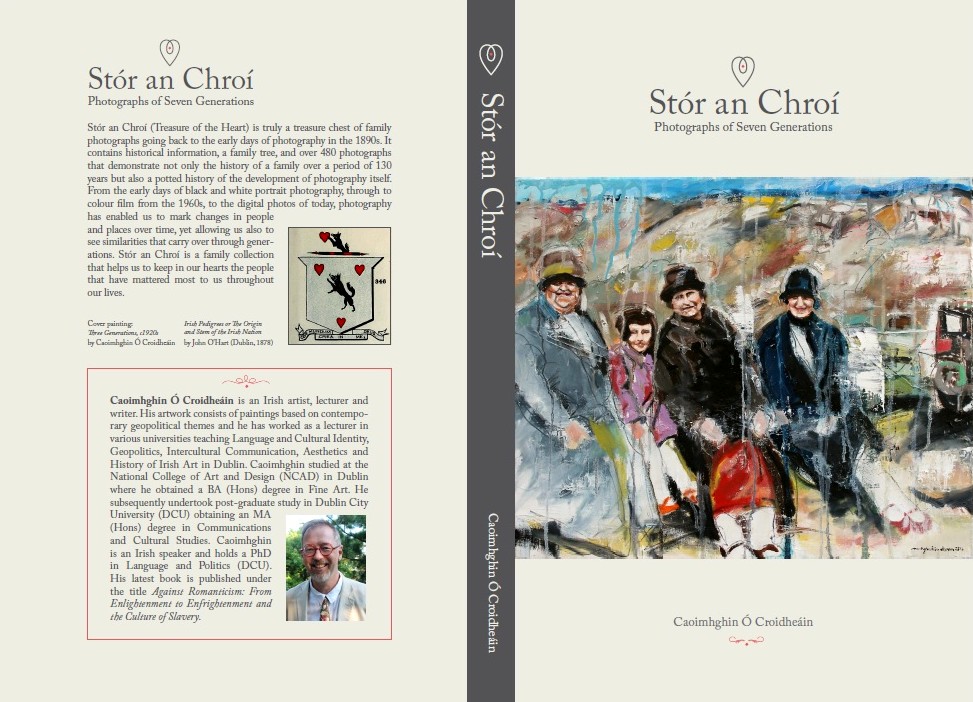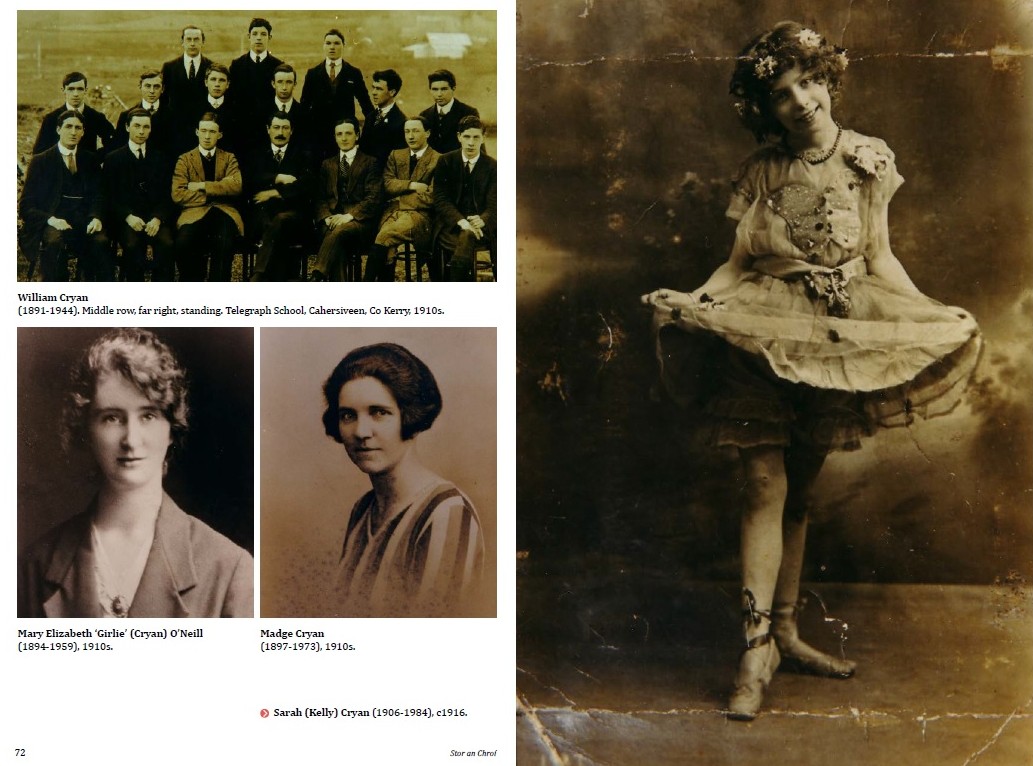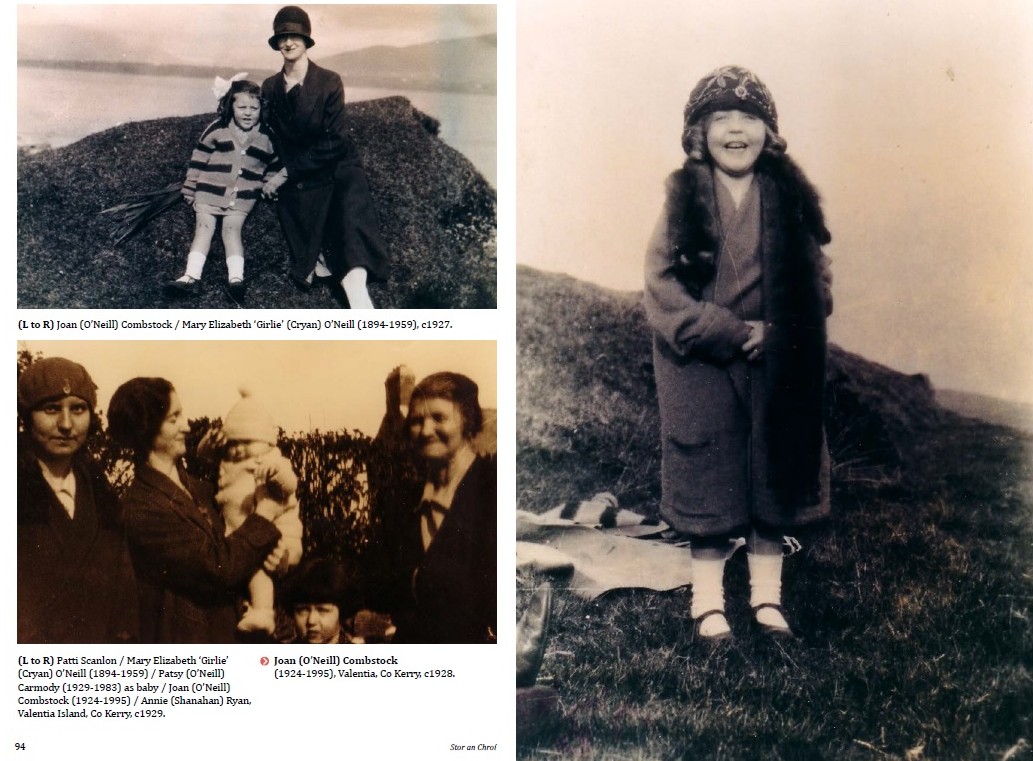
|
Stór an Chroí
Photographs of Seven Generations
|
Caoimhghin Ó Croidheáin
(see also art website)
Stór an Chroí: Photographs of Seven Generations
Gaelart Publishing
Pages: 371
Design: Noel Anderson (https://noelanderson.work)
Cover painting: Three Generations, c1920s by Caoimhghin Ó
Croidheáin (http://gaelart.net/)
Printer: Anglo Printers (https://www.angloprinters.ie/)
Full Colour
Typeset in 12pt Cambria font
Published in Dublin, Ireland
ABSTRACT
Stór an Chroí (Treasure of the
Heart) is truly a treasure chest of family photographs going back to the
early days of photography in the 1890s. It contains historical information, a
family tree, and over 480 photographs that demonstrate not only the history of a
family over a period of 130 years but also a potted history of the development
of photography itself. From the early days of black and white portrait
photography, through to colour film from the 1960s, to the digital photos of
today, photography has enabled us to mark changes in people and places over
time, yet allowing us also to see similarities that carry over through
generations. Stór an Chroí is a family collection that helps us to keep
in our hearts the people that have mattered most to us throughout our lives.

Table of Contents:
Acknowledgements
Introduction
Family History
Family Tree
Photographs:
1800s
1900s
1910s
1920s
1930s
1940s
1950s
1960s
1970s
1980s
1990s
2000s
2010s
2020s
The Author
Caoimhghin Ó Croidheáin is an Irish
artist, lecturer and writer. His artwork consists of paintings based on
contemporary geopolitical themes and he has worked as a lecturer in various
universities teaching Language and Cultural Identity, Geopolitics, Intercultural
Communication, Aesthetics and History of Irish Art in Dublin. Caoimhghin studied
at the National College of Art and Design in Dublin where he obtained a BA (Hons)
degree in Fine Art. He subsequently undertook post-graduate study in the
interdisciplinary field of Cultural Studies in Dublin City University obtaining
an MA (Hons) degree in Communications and Cultural Studies. Caoimhghin is an
Irish speaker and holds a PhD in Language and Politics (Dublin City University)
which is published under the title Language from Below: The Irish Language,
Ideology and Power in 20th-Century Ireland. Caoimhghin is a regular
contributor of articles on the arts, Irish culture, cultural politics, and the
environment, to sites such as Global Research, Dissident Voice, CounterPunch and
21cir.
Caoimhghin has just published his new book
– Against Romanticism: From Enlightenment to
Enfrightenment and the Culture of Slavery,
which looks at philosophy, politics and the history of 10 different art forms
arguing that Romanticism is dominating modern culture to the detriment of
Enlightenment ideals. It is available on Amazon (amazon.co.uk)
and the info page is here.
Dedication
For those who are gone, and those yet to
come ...
Epigraphs
"I am bound to them though I cannot look into their eyes or hear their
voices. I honor their history. I cherish their lives. I will tell their story. I
will remember them for I am the result of the very love, struggle, sacrifice and
journey of thousands."
Unknown
"Stories have to be told or they die, and when they die, we can’t remember
who we are or why we’re here."
Sue Monk Kidd
"You live as long as you are remembered."
Russian Proverb

Introduction
When my father died in 1990, many people came to his funeral, and then to our
house in Swords afterwards. Sitting across from me at the kitchen table was an
elegant elderly lady that I didn't recognise. I asked my mother who she was, and
was told that she was Teda, my grand aunt. Teda had been married to Patrick
Cryan, my grandfather's brother, and was the last of her generation of my
relatives. I realised there and then that I knew very little about my family
history and decided to start finding out.
I had no idea how to do genealogical research so I bought some books and family
history magazines. I went to libraries and archives, going through microfilmed
newspapers and dusty boxes of census returns. I met, and got to know
professional genealogists who advised me on research directions.
Our current knowledge of the history of our family is the culmination of
research undertaken in many different research institutions, e.g., the National
Library, the Valuation Office, the Public Records Office, the Registry of
Births, Deaths and Marriages, the Army archives, the Garda archives, the
Registry of Deeds, the Co Roscommon Heritage and Genealogical Centre, and
Roscommon County Library.
I had invaluable help and co-operation from genealogists, local newspapers who
published my letters, fellow Cryan family researchers and in particular
relatives who lent me photos and documents and told me of their own lives.
Now, things are so different as genealogy has become accepted in general and so
many archives have been digitised, and are very easily accessible on the
internet.
The digitisation of newspapers, deeds, and records globally has allowed for the
discovery of information based on particular keyword researches. Whereas once I
spent hours scanning microfilms for tidbits of information, now a search on a
genealogical website produces abundant results in seconds.
The earliest, proven Cryan ancestor I have been able to find is John Cryan
(1833-1905) who married Bridget Dolan in 1858. There is a scarcity of earlier
documentary sources that would allow us to name previous generations.
However, the latest aspect of modern research, DNA testing, has proven to be
extremely beneficent. While family history research is generally original
research specific to the family involved, DNA research is also original research
but on a general, global level. Since I teamed up with the genetic genealogist,
Michael Crow, on his Cryan/Crean/Crehan Facebook group, and took the DNA test,
extraordinary information has come to light.

I had always believed that the Roscommon Cryans of the eighteenth century were
simply a continuation of the Creans of Sligo as they moved away from their
seventeenth century power-base in Sligo. A change of accent resulted in a change
of phonetic, and therefore a change in spelling. Also I had never seen a Cryan
phonetic older than 1749 (Crien, Elphin Diocese Census).
Yet the testers we have in our surname project on FTDNA (familytreedna.com) have
shown a different story. I have a common ancestor with Dermot Cryan that lived
in the 1650s, and we have a common ancestor with Peter Cryans from Scotland that
lived in the 1550s. This shows that the Cryan phonetic has remained the same for
nearly 500 years (the spelling is irrelevant as surnames were standardized, for
example my great grandfather was registered as Joseph Crine). We are not sure if
there is any DNA connection between the Sligo Creans and the Roscommon Cryans,
at least until we get a tester with a proven connection to the 17th century
Sligo Creans.
Furthermore, it turns out that my Cryan line has a common paternal line ancestor
with Kilteasheen 33, a man who lived between 600 - 1300 CE during the Medieval
Age and was found in the region now known as The Bishop’s Seat, Kilteasheen in
Roscommon. This demonstrates the longevity of the Cryan connection with places
in Co Roscommon, a line that originally migrated to the north-west of Ireland
from Britain through northern Ireland.
I have gone through my original 1993 report material, updating it in the
process. Here is the story of a family history covering seven generations
starting with John Cryan (1833-1905).

|